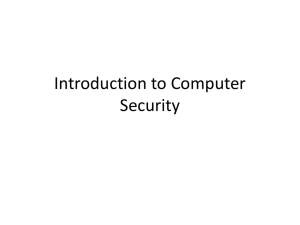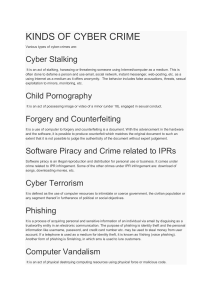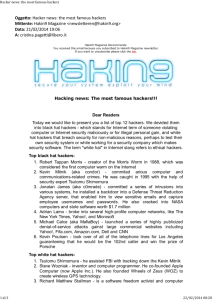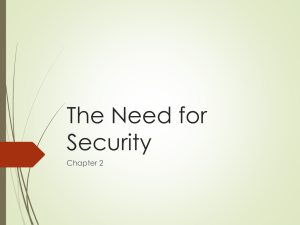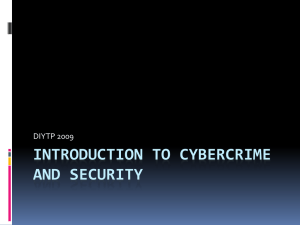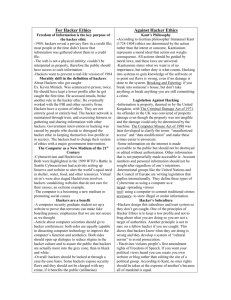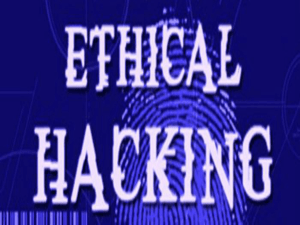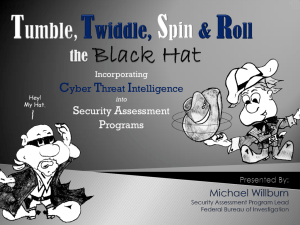Introduction to Computer Security
advertisement
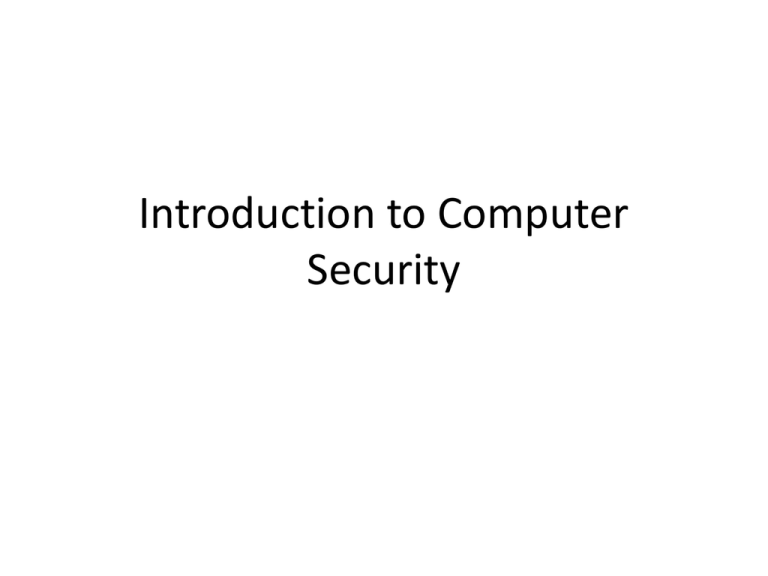
Introduction to Computer Security Introduction to Computer Security • Books: 1. An Inroduction to Computer Security: The NIST Handbook 2. Johannes Buchmann: Introduction to Cryptography 3. Douglas Stinson: Cryptography Theory and Practice I. Outline of the semester • Term of computer security • Elements of computer security • Three major security controls: Administrative controls, Physical controls, Algorithmic controls: Cryptography – encryption (symmetric, asymmetric), hash functions, digital signatures, message authentication codes, identification, key exchange etc. II. Computer Security • The protection afforded to an automated information system in order to attain the applicable objectives of preserving the integrity, availability and confidentiality of information system resources (includes hardware, software, information/data) II. Computer Security • Integrity: data integrity: Requirement that information and programs are changed only in a specified and authorized manner system integrity: Requirement that a system performs its intended function free from unauthorized manipulation II. Computer Security • Availability: Requirement intended to assure that systems work promptly and service is not denied to authorized users. • Confidentiality: Requirement that private or confidential information not be disclosed to unauthorized individuals. II. Elements of Computer Security 1. Computer security supports the mission of the organization 2. Computer security is an integral element of sound management 3. Computer security should be cost-effective 4. Computer security responsibilities should be made explicit 5. System owners have computer security responsibilities outside their own organizations 6. Computer security requires a comprehensive and integrated approach 7. Computer security should be periodically reassessed 8. Computer security is constrained by societal factors II. Computer security supports the mission of the organization • Computer security helps the organization’s mission by protecting its physical and financial resources, reputation, legal position, employees, and other tangible and intangible assets. • No complete security protecting important assets • usually security is secondary (making profit, providing good service etc. is primary) • Management should understand their mission and how their information system supports it. security requirements are defined • Interorganizational systems e.g.: good security of buyers system also benefits the seller II. Computer security is an integral element of sound management • Information and computer systems are often critical assets that support the mission of an organization. Protecting them can be as critical as protecting other organizational resources (e.g. money, physical assets, employees) • Managers should decide about the level of risk they are willing to accept. II. Computer security should be costeffective • Ensure that the cost of controls does not exceed expected benefits. • Direct costs: purchasing, installing and administering security systems • Indirect costs: Security systems can sometimes affect system performance, employee morale or retraining requirements. II. Computer security responsibilities should be made explicit • Document that states organization policy and make explicit computer security responsibilities • Responsibilities may be internal to an organization or may extend across organizational boundaries. II. Computer security requires a comprehensive and integrated approach • Interdependencies of security controls – Administrative, physical and algorithmic controls work together interdependancies e.g.: training on how to use a secure system • Other interdependencies – system management, legal issues, quality assurance II. Computer security should be periodically reassessed • Computers and the environments they operate in are dynamic security requirements are ever-changing • Changes in the system or the environment can create new vulnerabilities necessary to reassess periodically II. Computer security is constrained by societal factors • Security may be limited by social issues e.g. security vs. privacy (identification, tracking actions) III. Roles and Responsibilities • Whose responsibility is it? • Senior management • Computer Security Management • Program and Functional Managers/Application owners • Technology providers • Supporting organizations • Users III. Senior management • Senior management – ultimate responsibility They establish the organization’s computer security program to support the mission of the organization. They are responsible for setting a good example for their employees III. Computer Security Management • Directs the organization’s day-to-day management of its computer security program • Responsible for coordinating all securityrelated interactions among organizational elements. III. Program and Functional Managers/Application owners • Responsible for a program or function including the supporting computer system. • These officials are usually assisted by technical staff. III. Technology providers • Managers and technicians who design and operate computer systems. • They are responsible for implementing technical security on computer systems. • Responsible for being familiar with security technology that relates to their system. • Responsible for analyzing technical vulnerabilities. • Telecommunications – providing communication services (fax, voice, etc.) • Help desk – recognize security incidents and refer the caller to the appropriate person or organization for a response III. Supporting organizations • Audit – Auditors are responsible for examining systems whether the system is meeting stated security requirements. • Quality assurance – Responsible for improving the products and services, how computer security can be used to improve the quality. • Training office – Responsible for training users, operators, managers in computer security. • Risk Management – Responsible for studying all types of risks including computer securityrelated risks. III. Users • Users of information Individuals who use information provided by the computer system. They may read computerprepared reports etc. • Users of systems Individuals who directly use computer systems, responsible for following security procedures, reporting security problems, attending security training. IV. Threats • Threats range from errors harming database integrity to fires destroying entire computer centers • Threats from the actions of trusted employees, outside hackers, careless data entry clerks etc. • Attack confidentiality, integrity of data or availability of a system IV. Threats • Knowledge of threat environment is necessary for system manager to implement the most cost-effective security measures. • It might be more cost-effective to simply tolerate the expected losses risk analysis IV. Errors and omissions • Threat to data and system integrity • Made by users who create and edit data training can help • Large percentage of threats • Contribute directly or indirectly to security problems IV. Errors and omissions • Directly: data entry error or programming error that crashes a system • Indirectly: errors create vulnerabilities • Errors in programming are called bugs • Installation and maintenance errors security vulnerabilities IV. Fraud and theft • Automating traditional methods of fraud and theft • E.g.: financial systems are at risk, systems that control access to any resource (inventory systems etc.) • Insiders (former employees also) are in a better position, outsiders • Hardware and software are vulnerable to theft IV. Employee sabotage • Employees know what actions might cause the most damage • Employee sabotage is believed to be much smaller than the instances of theft, but the cost of such incidents can be quite high. IV. Loss of physical and Infrastructure support • Includes power failures, loss of communication, water leaks, lack of transportation service, fire, flood etc. • Loss of infrastructure often results in unexpected ways IV. Malicious hackers/crackers • A hacker breaks into computers and computer networks, either for profit or motivated by the challenge. • Black hat (crackers) hackers: for malicious reasons such as vandalism, credit card fraud, identity theft, piracy, or other types of illegal activity • White hat hackers: for non-malicious reasons, for instance testing their own security system • Grey hat hackers: combination of a Black Hat and a White Hat Hacker (repair the system for a small fee) IV. Malicious hackers/crackers • Losses due to hacker attacks are significantly smaller than losses due to insider theft and sabotage, the hacker problem is widespread and serious. • Receive more attention: hacker threat is a more recently encountered threat, organizations do not know the purpose of a hacker (browse, steal, damage, etc.) no limitations, hackers’ identity is unknown (case of painter and burglar) IV. Industrial espionage • Gathering proprietary data from private companies or the government for the purpose of aiding another company. • Goal is to improve their competitive advantage . • Since information is processed and stored on computer systems, computer security can help. (employees may sell information) • E.g.: pricing information, product development, customer lists, sales data, cost data, strategic plans IV. Malicious code • Virus: A code segment that replicates by attaching copies of itself to existing executables. The new copy of the virus is executed when a user executes the new host program. • Trojan horse: A program that performs a desired task, but that also includes unexpected functions. They steals information, harm the system and do not replicate themselves. IV. Malicious code • Worm: A self-replicating program that is selfcontained and does not require a host program. The program creates a copy of itself and causes it to execute, no user intervention is required. Sometimes just consume bandwith. IV. Threats to personal privacy • Electronic information about individuals by governments, credit bureaus, private companies, etc. have created a threat to individual privacy. • Often referred to „Big Brother”. • Federal and state employees have sold personal information collected by the government. (1992, USA) V. Administrative controls – Risk management • Risk is the possibility of something adverse happening. • Risk management is the process of assessing risk, taking steps to reduce risk to an acceptable level and maintaining that level of risk. • Computer security risk management addresses risks which arise from an organization’s use of information technology. V. Administrative controls – Risk management • E.g.: To maximize the return on their investments, businesses must often decide between aggressive (but high-risk) and slow-growth (but more secure) investment plans. These decisions require analysis of risk. Management decides • There is always risk. (from trusted employees or fire etc.) • Risk management is made up of three activities: risk assessment, risk mitigation and uncertainty analysis V. Administrative controls – Risk management – Risk assessment • Risk assessment: Process of analyzing and interpreting risk Basic activities: • determining the assessment’s scope and methodology • Collecting and analyzing data • Interpreting the risk analysis results V. Administrative controls – Risk management – Risk mitigation Selecting safeguards • Method of selecting safeguards: what if analysis to test what difference each makes with regard to cost, effectiveness and other factors • E.g.: what if passwords are strengthened? Personnel may be required to change passwords more frequently. There are no direct monetary expenditure, but staff and administrative overhead is increased. V. Administrative controls – Risk management – Uncertainty analysis • Risk management often must rely on speculation, best guesses, incomplete data, and many unproven assumptions. • Sources of uncertainty: lack of confidence or precision in the risk management model or lack of sufficient information to determine the exact value of the elements of the risk model VI. Computer Support and Operations (Regulations) • This includes both system administration and tasks external to the system that support its operation (e.g., maintaining documentation). It does not include system planning or design. • Support and operations are routine activities that enable computer systems to function correctly. (e.g. fixing software or hardware problems, maintaining software) VI. Computer Support and Operations • User Support: – through a Help Desk – which problems are security-related – they may not be aware of the "whole picture„ • Software Support: – controlling what software is used on a system ( must not load any) – ensure the software has not been modified without proper authorization (This can be done with a combination of logical and physical access controls.) VI. Computer Support and Operations • Configuration Management: – process of keeping track of changes to the system and, if needed, approving them – the security goal is to know what changes occur, not to prevent security from being changed • Backups: – Support and operations personnel and sometimes users back up software and data – Frequency of backups will depend upon how often data changes and how important those changes are. – Finally, backups should be stored securely VI. Computer Support and Operations • Logging: – to support accountability – Control numbers (or other tracking data), the times and dates of transfers, names and signatures of individuals involved, and other relevant information • Integrity Verification: – no modification – error detection and correction, cryptographicbased technologies VII. Physical and environmental security • Physical Access Protection: – Media can be stolen, destroyed, replaced with a look-alike copy, or lost. – Physical access controls, which can limit these problems, include locked doors, desks, file cabinets, or safes. • Environmental Protection: – media should be protected against heat, liquids, dust etc. • Disposition – The process of removing information from media is called sanitization. – e.g.: overwriting, destruction by shredding or burning VII. Physical and environmental security • refers to measures taken to protect systems, buildings, and related supporting infrastructure against threats associated with their physical environment • three areas: – the building, other structure, or vehicle housing the system and network components; determine the level of such physical threats as fire, roof leaks, or unauthorized access – facility's general geographic operating location determines the characteristics of natural threats, which include earthquakes and flooding; man-made threats such as burglary or damaging nearby activities, including toxic chemical spills, explosions, fires, and electromagnetic interference – system's operation usually depends on supporting facilities such as electric power, heating and air conditioning, and telecommunications. VII. Physical and environmental security • Interception of Data – Direct Observation - terminal and workstation display screens – Interception of Data Transmissions - access to data transmission lines – Electromagnetic Interception - Systems routinely radiate electromagnetic energy that can be detected with special-purpose radio receivers. (TEMPEST attack) Algorithmic Control – Identification, Entity authentication • Identification is the means by which a user provides a claimed identity to the system. • Entity authentication is the means of establishing the validity of this claim. – something the individual knows (e.g.: password, PIN) – something the individual possesses (e.g.: smart card, token) – something the individual is (e.g.: biometric)


